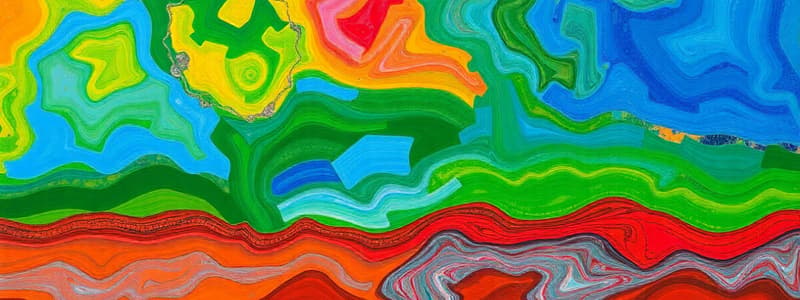Podcast
Questions and Answers
Which process is primarily responsible for the formation of mountains due to plate movement?
Which process is primarily responsible for the formation of mountains due to plate movement?
- Weathering
- Erosion
- Tectonics (correct)
- Glaciation
What aspect of geography focuses on the distribution of plants and animals across different regions?
What aspect of geography focuses on the distribution of plants and animals across different regions?
- Biogeography (correct)
- Hydrology
- Climatology
- Soil Geography
Which method uses satellite imagery to gather information about the Earth?
Which method uses satellite imagery to gather information about the Earth?
- Spatial Analysis
- Field Surveys
- Remote Sensing (correct)
- Cartography
In physical geography, which component examines the distribution and cycles of water in different forms?
In physical geography, which component examines the distribution and cycles of water in different forms?
Which of the following is NOT a key component of physical geography?
Which of the following is NOT a key component of physical geography?
What is the significance of understanding spatial relationships in geography?
What is the significance of understanding spatial relationships in geography?
Which term describes the breakdown of rocks and minerals that influences landforms?
Which term describes the breakdown of rocks and minerals that influences landforms?
Which application of geography involves designing and developing cities?
Which application of geography involves designing and developing cities?
What process creates features such as fjords and moraines?
What process creates features such as fjords and moraines?
Which branch of geography would study the impacts of climate zones on ecosystems?
Which branch of geography would study the impacts of climate zones on ecosystems?
Flashcards are hidden until you start studying
Study Notes
Physical Geography
- Definition: Study of natural features and processes of the Earth.
- Key Components:
- Landforms: Mountains, valleys, plateaus, and plains; shaped by tectonic activity and erosion.
- Hydrology: Study of water in all forms, including rivers, lakes, aquifers, and oceans; examines water cycles and distribution.
- Climatology: Analysis of climate and weather patterns; understanding climate zones and their effects on ecosystems.
- Biogeography: Distribution of flora and fauna; explores ecosystems and biodiversity across different regions.
- Soil Geography: Study of soil types and their properties; impact on agriculture and environmental quality.
- Processes:
- Tectonics: Movement of Earth's plates causing earthquakes and mountain formation.
- Erosion and Weathering: Breakdown of rocks and mineral materials; influences landforms and soil quality.
- Glaciation: Impact of glaciers on landscapes; creates features such as fjords and moraines.
- Natural Hazards: Study of earthquakes, tsunamis, hurricanes; understanding risk and mitigation strategies.
Geography as a Discipline
- Definition: Interdisciplinary field that examines spatial relationships and patterns on Earth.
- Branches of Geography:
- Human Geography: Focuses on human activities, cultures, economies, and their interactions with the environment.
- Physical Geography: Studies natural processes and features of the Earth, as detailed above.
- Methods:
- Spatial Analysis: Use of geospatial technologies, such as GIS (Geographic Information Systems) to analyze spatial data.
- Field Surveys: Collecting data through observation and measurement in different environments.
- Remote Sensing: Satellite imagery and aerial photography to gather information about the Earth.
- Applications:
- Urban Planning: Designing and developing cities based on geographic principles.
- Environmental Management: Sustainable use of natural resources and conservation efforts.
- Transportation: Analysis and infrastructure planning based on geographic considerations.
- Importance:
- Provides understanding of global issues, such as climate change, urbanization, and resource management.
- Enhances critical thinking about the relationships between people, place, and environment.
Physical Geography
- Definition: Study of Earth's natural features and their processes.
- Key Components:
- Landforms: Formed by tectonic activity and erosion, including mountains, valleys, plateaus, and plains.
- Hydrology: Water cycle and distribution analysis, including rivers, lakes, aquifers, and oceans.
- Climatology: Climate and weather patterns analysis, understanding climate zones and their impact on ecosystems.
- Biogeography: Distribution of plants and animals, exploring ecosystems and biodiversity across different regions.
- Soil Geography: Soil types and their properties, including impact on agriculture and environmental quality.
- Processes:
- Tectonics: Earth's plates movement, causing earthquakes and mountain formation.
- Erosion and Weathering: Breakdown of rocks and minerals, influencing landforms and soil quality.
- Glaciation: Glaciers' impact on landscapes, creating features like fjords and moraines.
- Natural Hazards: Study of earthquakes, tsunamis, hurricanes, understanding risks and mitigation strategies.
Geography as a Discipline
- Definition: Interdisciplinary field focusing on spatial relationships and patterns on Earth.
- Branches of Geography:
- Human Geography: Focuses on human activities, cultures, economics, and their interaction with the environment.
- Physical Geography: Study of Earth's natural processes and features, as described above.
- Methods:
- Spatial Analysis: Using geospatial technologies like GIS (Geographic Information Systems) for analyzing spatial data.
- Field Surveys: Collecting data through observation and measurements in different environments.
- Remote Sensing: Gathering information about the Earth using satellite imagery and aerial photography.
- Applications:
- Urban Planning: Designing and developing cities based on geographic principles.
- Environmental Management: Sustainable use of natural resources and conservation efforts.
- Transportation: Analysis and infrastructure planning based on geographic considerations.
- Importance:
- Provides understanding of global issues like climate change, urbanization, and resource management.
- Enhances critical thinking about the relationships between people, place, and environment.
Studying That Suits You
Use AI to generate personalized quizzes and flashcards to suit your learning preferences.




